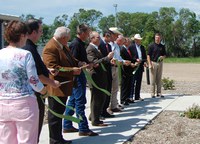New Facility Enhances NDSU Beef Research
(Click the image below to view a high-resolution image that can be downloaded)
North Dakota State University’s new, state-of-the art Beef Cattle Research Complex is taking beef cattle research to a new level.
“This facility is the piece we needed to allow us to meet the challenges of 21st century beef cattle production,” says D.C. Coston, NDSU vice president for Agriculture and University Extension. “It complements intensive campus-based facilities such as the Animal Nutrition and Physiology Center and the extensive research capabilities at the Research Extension Centers in Carrington, Streeter, Hettinger and Dickinson.”
NDSU officials dedicated the facility Wednesday and gave visitors a glimpse of what will take place there.
“This is a great facility that will enhance our research efforts on management, reproduction, nutrition and physiology of beef cattle,” says Ken Grafton, director of the North Dakota Agricultural Experiment Station (NDAES) and dean of NDSU’s College of Agriculture, Food Systems, and Natural Resources. “The ability to carry out precise experiments in these areas will greatly impact the beef cattle industry in the state for many years.”
The complex, which can accommodate up to 192 cattle, consists of a feeding area, cattle handling system, calving pens, an office and laboratory area, and a facility for mixing and storing feed.
Only three other research facilities in North America have the same specialized feeding equipment. This equipment is a key component in NDSU’s beef research because researchers will be able to measure and control feed intake for cattle individually and provide a variety of diets for cattle in the same pen, according to Greg Lardy, head of NDSU’s Animal Sciences Department.
The feed facility will allow researchers to mix, store and feed cattle ingredients including hays, grains, silages, wet and dry byproducts, and dry and liquid supplements.
Researchers will be able to use ultrasonography to determine pregnancy or carcass quality and collect tissue samples in the handling facility. The handling system also can process and weigh all classes of cattle.
Nutrition and reproductive physiology research in growing cattle and pregnant and lactating beef cows will be among the first projects conducted at the complex.
The complex was constructed using a combination of state and federal dollars totaling more than $3 million.
Development of the complex began in 2007 with the State Board of Agricultural Research and Education (SBARE) identifying it as state capital project funding priority 3 for the NDAES. NDSU requested $950,000 for the initial phase of construction. The North Dakota Legislature provided $80,000 in planning funds and authorized NDSU to expend $1 million in special (nonstate) funds on the facility.
The NDAES worked with the U.S. Department of Agriculture the following year to utilize a USDA grant for the initial phase. The complex’s feeding barn was constructed and site work was completed late in the fall of 2008 at a cost of $701,900.
In 2009, SBARE identified the complex as capital funding priority 2. The Legislature provided the entire $2,612,400 that NDSU requested to complete complex.
Construction continued in 2010, and the facility was completed this spring.
“We greatly appreciate the strong support of the North Dakota Stockmen’s Association, the North Dakota Beef Commission and the State Board of Agricultural Research and Education as we envisioned this complex,” Grafton says. “We also give special thanks to the governor’s office and the Legislature for allowing this facility to be established on the NDSU campus.”
NDSU Agriculture Communication - June 29, 2011
| Source: | D.C. Coston, (701) 231-7656, d.c.coston@ndsu.edu |
|---|---|
| Source: | Ken Grafton, (701) 231-7655, k.grafton@ndsu.edu |
| Editor: | Ellen Crawford, (701) 231-5391, ellen.crawford@ndsu.edu |


